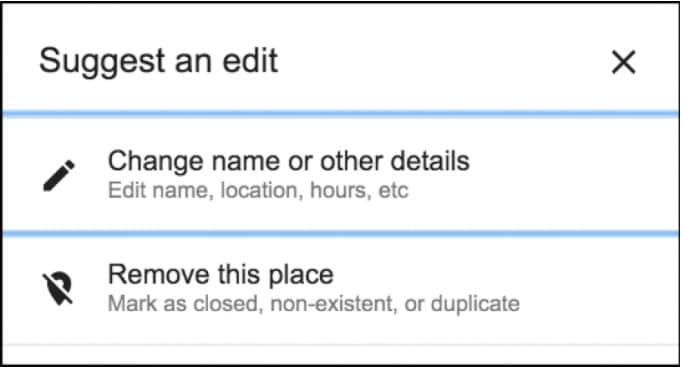Your competitor’s GMB spam can cost a local business big in lost customers and revenue
Google My Business is a terrific free tool that makes it easier for potential customers to find your business. However, the amount of GMB listings are increasing every day. It means that cases of GMB spam is also rising, and business owners should focus on this problem. Unfortunately, it’s hard for Google to detect all the GMB spam that gets posted, so you must monitor the issue, and your competitors closely. Before you can do that you’ll need learn the different types of GMB Spam and helpful ways to combat it. Let’s get started!
Types of Google My Business (GMB) Spam
It’s crucial to know the different GMB Spam types to identify it when you see one immediately.
Keywords in Names is an example of competitor GMB spam
These are the GMB listings that include industry or location keywords in their names. Some add both keywords, and it results in stuffing their business names with unnecessary words. Businesses try this keyword strategy to boost their SEO. However, those gains are temporary because sooner or later Google catches up with the offender and punishment is rendered.
Why? Let’s look at the reasons.
- First, keyword-stuffed names don’t look good in the eye.
- Second, it’s against Google’s guidelines.
- Third, if you get caught doing this, you will get suspended, and it will be hard to reinstate your listing.
Unfortunately, it may take some time before Google recognizes the spam and your competitor may enjoy a significant advantage until the do and suspend the competition’s listing.
Duplicate Listings
Spammers that create duplicate listings want to increase exposure and boost their local SEO efforts. They do this by making variations of their names. For example, let’s say that a sneaker boutique’s name on its first listing is “Sneaker Show.” For the second listing, the business adds something to its name and makes it “The Sneaker Show, Inc.” See the modifications?
Spammers also use false business addresses to confuse Google further and defeat its algorithm. It may look like this trick can help a business attract more customers, but it will eventually backfire. Imagine the disappointment that customers will feel when they find out that the business information they relied on is fabricated. Duplicate listings hurt business more than they help but some shady characters.
Ghost Business Listings
Ghost business listings is an egregious form of competitive GMB spam. They exist for several reasons, most of them nefarious in nature. They are often started to commit fraud, launder money or evade taxes. Since Google listings are so simple, and affordable to set up they are easy targets for fraudsters and other unsavory characters. In SEO, they are established to create a location where none exists. This is done primarily to do better in maps searches that contain “near me” in the query. If a companies target marketing is located in an area far from the business’s location, a ghost listing can solve that dilemma.
How to report a GMB spam listing
Now that you have found spam in a Competitor’s GMB listing, here is the action you can take.
Edit the Information
The fastest way to challenge spammy content is to ask Google to change it. Every Google location has an “Suggest an edit” link. When you click on the link there will 2 options that you can choose from.

Here you can challenge spam content. For instance, if Smith’s Bakery has a GMB listing calling itself “Best Bridgeport Donuts” this is reportable spam that Google may penalize.
If you choose “Remove this place” be sure you have proof the location really doesn’t exist or is closed. Google normally won’t take your word for it. An image of the actual location without the offending business will usually be enough.
File a complaint with Google
In 2019 Google introduced a Redress Complaint Form. Here you can state specifically why a location is spam or doesn’t exist at all. The form has several sections that must be completed. Name, email, name of the offending location etc. Again, be specific and complete answering all the questions. Google allows you to upload pertinent files. Refer to them in you text when writing your complaint.
After filing your complaint Google will send an acknowledgment email. It may take several days for Google to give you a response. Often, they will deny your claim. If that happens, follow Google Guidelines, and resubmit the claim. Include additional information if requested or is pertinent to your case. Human eyes look at the claims and it’s possible another arbitrator will have a different opinion of the facts.
If your complaint is accepted and the location is suspended, sit back and wait. It’s quite possible the offending business will be reopened under a new, possibly spammy, name and location.
Review Spam
We can’t end without talking a bit about review spam. Review spam are reviews that are keyword rich in the praise of a business. Let’s use Smith’s Bakery AKA Best Bridgeport Donuts for an example. “If you want the best Bridgeport donuts visit Best Bridgeport Donuts. They are the best Bridgeport donuts we have ever had.” Yes, we have seen reviews like this. To report review spam, go to the link “View all Google reviews” on the offending businesses Google listing . Next to each review in the upper right-hand corner you will see 3 vertical dots. Click on it and “Report review” will display.

They give you a choice of five responses: This review is not relevant to this place; Conflict of interest; Offensive or sexually explicit; Privacy concern; Legal issue. Choose the one that fits the situation and click submit. As always, what Google does with your complaint can not be predicted.
And finally!
GMB spam and Local Guides
Local Guides is a group of people who write reviews of businesses on Google Map locations. There are different levels Guides can attain, 1 to 10. Confession, I am a Level 5 Guide. Guides get points for the reviews they leave. Points can be traded in for Google rewards. I have been offered discounts at Google Play. It is almost humanly impossible to attain the highest level, 100,000 points. At level 5 I have 1004 points. To attain the most points, you need to leave tons of reviews and entice visitors who read your review to respond to it. To do that Guides leave must leave either very good or very bad reviews. A challenge: find me a Guide who left a 3-star review.
Not surprising then that some Local Guides are less than honest with some of their reviews. We had a situation once when a Level 6 Guide left a 5-star review for a business in Ohio minutes after leaving a 1-star review for a client of ours in Connecticut (we got it removed). Competitor’s may ask a local guide to leave a fraudulent review for them (positive) or a negative one for you. Don’t be intimidated by a review left by a Local Guide. Follow the procedures outlined above.
